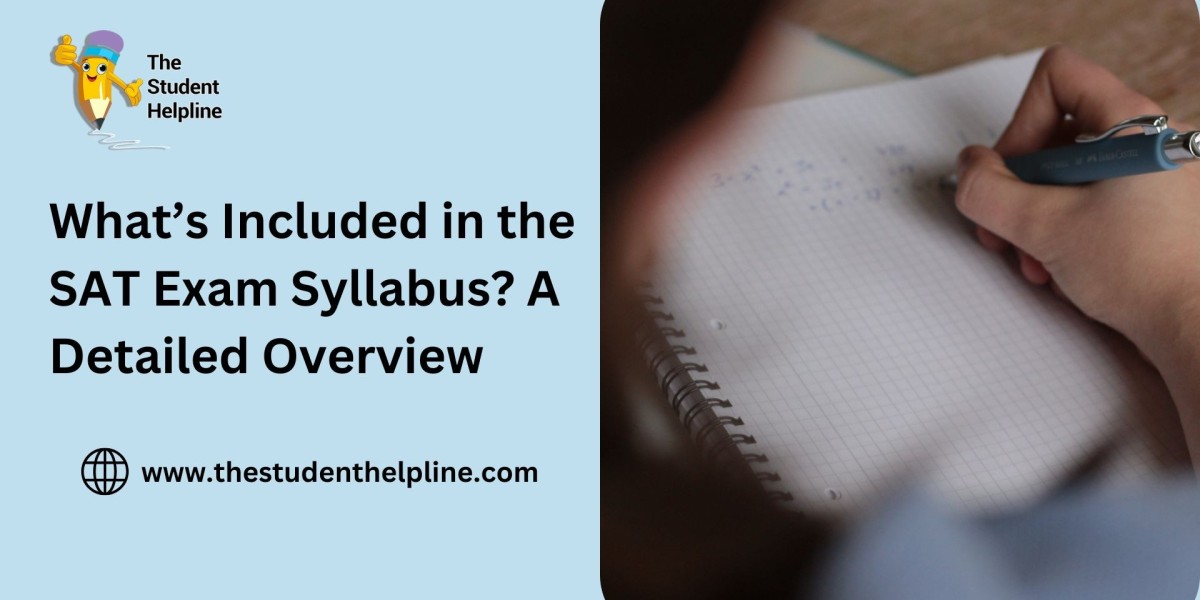The SAT exam is one of the most critical standardized tests for students seeking admission to colleges and universities, primarily in the United States. Understanding the SAT exam syllabus is crucial for students to plan their preparation effectively. This article provides a detailed overview of the SAT exam syllabus, breaking down each section and offering tips on how to approach them for maximum success.
Overview of the SAT Exam
The SAT exam is designed to measure a student's readiness for college by assessing skills in reading, writing, and mathematics. It consists of three main sections: Evidence-Based Reading and Writing, Math, and the optional Essay. The exam is scored on a scale of 400 to 1600, with each of the two major sections—Reading and Writing, and Math—being scored from 200 to 800 points.
SAT Exam Syllabus: Key Sections
1. Evidence-Based Reading and Writing
This section is divided into two parts: Reading and Writing. It tests your ability to interpret and analyze texts and your understanding of grammar and syntax.
Reading:
The reading section contains 52 multiple-choice questions, and you are given 65 minutes to complete it. The questions are based on passages that may include literature, history, social studies, and science.
Key skills assessed:
- Understanding of the main idea and themes in passages
- Analyzing how authors use evidence to support arguments
- Interpreting the meaning of words in context
- Making inferences based on the text
Writing and Language:
In the writing section, you will be asked to answer 44 multiple-choice questions within 35 minutes. The passages provided will focus on grammar and usage, and your goal is to choose the best wording and sentence structure.
Key skills assessed:
- Proper use of grammar, punctuation, and sentence structure
- Editing passages for clarity, consistency, and overall style
- Understanding the logical flow of ideas within a passage
2. Math Section
The Math section is divided into two parts: one that allows the use of a calculator, and one that does not. The total number of questions in this section is 58, and the time allotted is 80 minutes.
No Calculator:
This part contains 20 questions, including both multiple-choice and grid-in questions. You will be required to solve problems without the use of a calculator, which tests your ability to solve basic arithmetic, algebra, and data analysis problems.
Key skills assessed:
- Arithmetic operations, including fractions, percentages, and ratios
- Algebra and linear equations
- Problem-solving and data interpretation
Calculator:
This part consists of 38 questions and allows you to use a calculator. These questions test more complex math skills, including algebra, advanced math, and problem-solving.
Key skills assessed:
- Advanced algebra, such as quadratic equations
- Functions, ratios, and proportions
- Word problems involving real-world scenarios
- Data interpretation, including statistics and probability
3. The SAT Essay (Optional)
Though the essay section is optional, some colleges require it for admission. If you choose to take it, you will have 50 minutes to analyze a passage and write a response. You will not be asked to share your opinion, but rather to explain how the author builds an argument using evidence and rhetorical devices.
Key skills assessed:
- Analyzing an author’s use of evidence and reasoning
- Writing a clear, coherent, and well-organized essay
- Using appropriate examples to support your analysis
How to Approach the SAT Exam Syllabus
Effective preparation for the SAT exam involves understanding the structure of each section and developing strategies for each. Here are some tips to help you prepare for each component of the SAT syllabus.
Evidence-Based Reading and Writing Tips
- Develop your reading skills: Read a variety of texts, including fiction, non-fiction, and scientific articles. Focus on understanding the author’s perspective and how they present their ideas.
- Practice grammar and sentence structure: Familiarize yourself with common grammar rules, sentence structures, and usage errors that the SAT typically tests.
- Work on time management: Since the reading section has a time limit, practice reading quickly while still understanding the content.
Math Section Tips
- Review basic concepts: Make sure you have a strong understanding of fundamental math concepts, such as algebra, geometry, and arithmetic.
- Practice problem-solving: SAT math questions often involve word problems, so practice translating real-world scenarios into mathematical equations.
- Familiarize yourself with calculator and non-calculator questions: Be comfortable with using a calculator efficiently, and also practice solving problems without one.
Essay Tips
- Practice analyzing arguments: Read editorial articles and practice identifying how the author uses evidence to make their point.
- Focus on structure: Write essays with a clear introduction, body paragraphs, and conclusion. Ensure your ideas are logically organized and easy to follow.
- Use examples effectively: Draw on specific examples to support your analysis and showcase your ability to think critically.
Importance of the SAT Exam Syllabus
The SAT exam syllabus is designed to measure the skills needed to succeed in college and beyond. By understanding each section's requirements, students can tailor their preparation to focus on the areas where they need the most improvement.
In addition to being a major factor in college admissions, the SAT exam can also help students qualify for scholarships and other opportunities. Therefore, it is crucial to approach your preparation with a focused strategy that aligns with the SAT exam syllabus.
Conclusion
The SAT exam syllabus encompasses a range of skills and content areas, from reading comprehension and writing to advanced mathematics. A well-rounded study plan, focusing on each section's requirements, will ensure that you are well-prepared to tackle the test and achieve your desired score. Whether you're focusing on reading, writing, math, or the optional essay, understanding the SAT exam syllabus is the first step toward success.
Naijamatta is a social networking site,
download Naijamatta from Google play store or visit www.naijamatta.com to register. You can post, comment, do voice and video call, join and open group, go live etc. Join Naijamatta family, the Green app.
Click To Download


